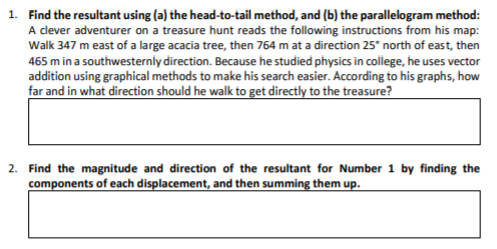1. Find the resultant using (a) the head-to-tail method, and (b) the parallelogram method: A clever adventurer on a treasure hunt reads the following instructions from his map: Walk 347 m east of a large acacia tree, then 764 m at a direction 25° north of east, then 465 m in a southwesternly direction. Because he studied physics in college, he uses vector addition using graphical methods to make his search easier. According to his graphs, how far and in what direction should he walk to get directly to the treasure? 2. Find the magnitude and direction of the resultant for Number 1 by finding the components of each displacement, and then summing them up.
1. Find the resultant using (a) the head-to-tail method, and (b) the parallelogram method: A clever adventurer on a treasure hunt reads the following instructions from his map: Walk 347 m east of a large acacia tree, then 764 m at a direction 25° north of east, then 465 m in a southwesternly direction. Because he studied physics in college, he uses vector addition using graphical methods to make his search easier. According to his graphs, how far and in what direction should he walk to get directly to the treasure? 2. Find the magnitude and direction of the resultant for Number 1 by finding the components of each displacement, and then summing them up.
College Physics
11th Edition
ISBN:9781305952300
Author:Raymond A. Serway, Chris Vuille
Publisher:Raymond A. Serway, Chris Vuille
Chapter1: Units, Trigonometry. And Vectors
Section: Chapter Questions
Problem 71P: A commuter airplane starts from an airport and takes the route shown in Figure P1.71. The plane...
Related questions
Question

Transcribed Image Text:1. Find the resultant using (a) the head-to-tail method, and (b) the parallelogram method:
A clever adventurer on a treasure hunt reads the following instructions from his map:
Walk 347 m east of a large acacia tree, then 764 m at a direction 25° north of east, then
465 m in a southwesternly direction. Because he studied physics in college, he uses vector
addition using graphical methods to make his search easier. According to his graphs, how
far and in what direction should he walk to get directly to the treasure?
2. Find the magnitude and direction of the resultant for Number 1 by finding the
components of each displacement, and then summing them up.
Expert Solution
This question has been solved!
Explore an expertly crafted, step-by-step solution for a thorough understanding of key concepts.
Step by step
Solved in 4 steps with 5 images

Knowledge Booster
Learn more about
Need a deep-dive on the concept behind this application? Look no further. Learn more about this topic, physics and related others by exploring similar questions and additional content below.Recommended textbooks for you

College Physics
Physics
ISBN:
9781305952300
Author:
Raymond A. Serway, Chris Vuille
Publisher:
Cengage Learning

College Physics
Physics
ISBN:
9781285737027
Author:
Raymond A. Serway, Chris Vuille
Publisher:
Cengage Learning

University Physics Volume 1
Physics
ISBN:
9781938168277
Author:
William Moebs, Samuel J. Ling, Jeff Sanny
Publisher:
OpenStax - Rice University

College Physics
Physics
ISBN:
9781305952300
Author:
Raymond A. Serway, Chris Vuille
Publisher:
Cengage Learning

College Physics
Physics
ISBN:
9781285737027
Author:
Raymond A. Serway, Chris Vuille
Publisher:
Cengage Learning

University Physics Volume 1
Physics
ISBN:
9781938168277
Author:
William Moebs, Samuel J. Ling, Jeff Sanny
Publisher:
OpenStax - Rice University

College Physics
Physics
ISBN:
9781938168000
Author:
Paul Peter Urone, Roger Hinrichs
Publisher:
OpenStax College

Physics for Scientists and Engineers, Technology …
Physics
ISBN:
9781305116399
Author:
Raymond A. Serway, John W. Jewett
Publisher:
Cengage Learning

Physics for Scientists and Engineers
Physics
ISBN:
9781337553278
Author:
Raymond A. Serway, John W. Jewett
Publisher:
Cengage Learning